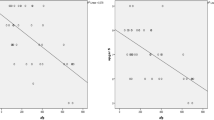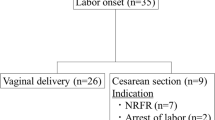Abstract
Purpose
Placental growth factor (PlGF) has been suggested as a possible biomarker for major placenta-related disorders such as preeclampsia and intrauterine growth restriction. However, experimental findings suggest that PlGF concentrations may be influenced by other factors besides the placenta. In the present study, we examined how acute fetal injury affects PlGF concentrations in maternal circulation. We therefore monitored PlGF concentrations in maternal circulation before and after feticide.
Methods
A prospective comparative study was performed. Blood samples were drawn prospectively between January and July 2012, before and after feticide at predetermined time points in relation to the procedure (0, 30, 60, and 120 min). The levels of lactate dehydrogenase (LDH) in the maternal circulation were measured to detect acute tissue damage. PlGF concentrations were measured by standard human ELISA.
Results
Following feticide (60 and 120 min), PlGF concentrations decreased significantly compared to the concentrations before feticide. LDH concentrations did not change before and after feticide.
Conclusions
Our finding, along with the detailed review of the literature described in our work, supports a new concept in which primary fetal distress can affect PlGF concentration in maternal circulation. A large-scale study is required to strengthen our finding.


Similar content being viewed by others
Abbreviations
- IUGR:
-
Intrauterine growth retardation
- LDH:
-
Lactate dehydrogenase
- PlGF:
-
Placental growth factor
- sFLT-1:
-
Soluble fms-like tyrosine kinase-1
- VEGF:
-
Vascular endothelial growth factor
References
Huppertz B (2011) Placental pathology in pregnancy complications. Thromb Res 127(Suppl 3):S96–S99
Odibo AO, Patel KR, Spitalnik A, Odibo L, Huettner P (2014) Placental pathology, first-trimester biomarkers and adverse pregnancy outcomes. J Perinatol Off J Calif Perinat Assoc 34(3):186–191
Vintzileos AM, Ananth CV (2014) First trimester prediction of ischemic placental disease. Semin Perinatol 38(3):159–166
Sibiude J, Guibourdenche J, Dionne MD, Le Ray C, Anselem O, Serreau R et al (2012) Placental growth factor for the prediction of adverse outcomes in patients with suspected preeclampsia or intrauterine growth restriction. PLoS One 7(11):e50208
Ghosh D, Sharkey AM, Charnock-Jones DS, Dhawan L, Dhara S, Smith SK et al (2000) Expression of vascular endothelial growth factor (VEGF) and placental growth factor (PlGF) in conceptus and endometrium during implantation in the rhesus monkey. Mol Hum Reprod 6(10):935–941
Maglione D, Guerriero V, Viglietto G, Delli-Bovi P, Persico MG (1991) Isolation of a human placenta cDNA coding for a protein related to the vascular permeability factor. Proc Natl Acad Sci USA 88(20):9267–9271
Kumasawa K, Ikawa M, Kidoya H, Hasuwa H, Saito-Fujita T, Morioka Y et al (2011) Pravastatin induces placental growth factor (PGF) and ameliorates preeclampsia in a mouse model. Proc Natl Acad Sci USA 108(4):1451–1455
Levine RJ, Maynard SE, Qian C, Lim KH, England LJ, Yu KF et al (2004) Circulating angiogenic factors and the risk of preeclampsia. N Engl J Med 350(7):672–683
Maynard SE, Min JY, Merchan J, Lim KH, Li J, Mondal S et al (2003) Excess placental soluble fms-like tyrosine kinase 1 (sFlt1) may contribute to endothelial dysfunction, hypertension, and proteinuria in preeclampsia. J Clin Invest 111(5):649–658
Benton SJ, Hu Y, Xie F, Kupfer K, Lee SW, Magee LA et al (2012) Can placental growth factor in maternal circulation identify fetuses with placental intrauterine growth restriction? Am J Obstet Gynecol 206(2):163e1-7
Romero R, Nien JK, Espinoza J, Todem D, Fu W, Chung H et al (2008) A longitudinal study of angiogenic (placental growth factor) and anti-angiogenic (soluble endoglin and soluble vascular endothelial growth factor receptor-1) factors in normal pregnancy and patients destined to develop preeclampsia and deliver a small for gestational age neonate. J Matern Fetal Neonatal Med 21(1):9–23
Wallner W, Sengenberger R, Strick R, Strissel PL, Meurer B, Beckmann MW et al (2007) Angiogenic growth factors in maternal and fetal serum in pregnancies complicated by intrauterine growth restriction. Clin Sci (Lond) 112(1):51–57
Signore C, Mills JL, Qian C, Yu K, Lam C, Epstein FH et al (2006) Circulating angiogenic factors and placental abruption. Obstet Gynecol 108(2):338–344
Espinoza J, Romero R, Nien JK, Kusanovic JP, Richani K, Gomez R et al (2006) A role of the anti-angiogenic factor sVEGFR-1 in the ‘mirror syndrome’ (Ballantyne’s syndrome). J Matern Fetal Neonatal Med 19(10):607–613
Stepan H, Faber R (2006) Elevated sFlt1 level and preeclampsia with parvovirus-induced hydrops. N Engl J Med 354(17):1857–1858
Kusanovic JP, Romero R, Espinoza J, Nien JK, Kim CJ, Mittal P et al (2008) Twin-to-twin transfusion syndrome: an antiangiogenic state? Am J Obstet Gynecol 198(4):382e1-8
Prefumo F, Pagani G, Fratelli N, Benigni A, Frusca T (2010) Increased concentrations of antiangiogenic factors in mirror syndrome complicating twin-to-twin transfusion syndrome. Prenat Diagn 30(4):378–379
Romero R, Chaiworapongsa T, Erez O, Tarca AL, Gervasi MT, Kusanovic JP et al (2010) An imbalance between angiogenic and anti-angiogenic factors precedes fetal death in a subset of patients: results of a longitudinal study. J Matern Fetal Neonatal Med 23(12):1384–1399
Gomez-Arriaga PI, Herraiz I, Lopez-Jimenez EA, Gomez-Montes E, Denk B, Galindo A (2013) Uterine artery Doppler and sFlt-1/PlGF ratio: usefulness in diagnosis of pre-eclampsia. Ultrasound Obstet Gynecol 41(5):530–537
Kleinrouweler CE, Wiegerinck MM, Ris-Stalpers C, Bossuyt PM, van der Post JA, von Dadelszen P et al (2012) Accuracy of circulating placental growth factor, vascular endothelial growth factor, soluble fms-like tyrosine kinase 1 and soluble endoglin in the prediction of pre-eclampsia: a systematic review and meta-analysis. BJOG 119(7):778–787
Livingston JC, Haddad B, Gorski LA, Neblett P, Ahokas RA, Ramsey R et al (2001) Placenta growth factor is not an early marker for the development of severe preeclampsia. Am J Obstet Gynecol 184(6):1218–1220
Widmer M, Villar J, Benigni A, Conde-Agudelo A, Karumanchi SA, Lindheimer M (2007) Mapping the theories of preeclampsia and the role of angiogenic factors: a systematic review. Obstet Gynecol 109(1):168–180
Taylor RN, Grimwood J, Taylor RS, McMaster MT, Fisher SJ, North RA (2003) Longitudinal serum concentrations of placental growth factor: evidence for abnormal placental angiogenesis in pathologic pregnancies. Am J Obstet Gynecol 188(1):177–182
Brancaccio P, Lippi G, Maffulli N (2010) Biochemical markers of muscular damage. Clin Chem Lab Med CCLM/FESCC 48(6):757–767
Cerdeira AS, Karumanchi SA (2012) Angiogenic factors in preeclampsia and related disorders. Cold Spring Harb Perspect Med 2(11). doi:10.1101/cshperspect.a006585
Ghosh SK, Raheja S, Tuli A, Raghunandan C, Agarwal S (2012) Serum PLGF as a potential biomarker for predicting the onset of preeclampsia. Arch Gynecol Obstet 285(2):417–422
Powers RW, Jeyabalan A, Clifton RG, Van Dorsten P, Hauth JC, Klebanoff MA et al (2010) Soluble fms-Like tyrosine kinase 1 (sFlt1), endoglin and placental growth factor (PlGF) in preeclampsia among high risk pregnancies. PLoS One 5(10):e13263
Llurba E, Marsal G, Sanchez O, Dominguez C, Alijotas-Reig J, Carreras E et al (2012) Angiogenic and antiangiogenic factors before and after resolution of maternal mirror syndrome. Ultrasound Obstet Gynecol 40(3):367–369
Goa S, Mimura K, Kakigano A, Tomimatsu T, Kinugasa-Taniguchi Y, Endo M et al (2013) Normalisation of angiogenic imbalance after intra-uterine transfusion for mirror syndrome caused by Parvovirus B19. Fetal Diagn Ther. doi:10.1159/000348778
Poret-Bazin H, Simon EG, Bleuzen A, Dujardin PA, Patat F, Perrotin F (2013) Decrease of uteroplacental blood flow after feticide during second-trimester pregnancy termination with complete placenta previa: quantitative analysis using contrast-enhanced ultrasound imaging. Placenta 34(11):1113–1115
Ruano R, Kondo MM, Bunduki V, Rodeck C, Zugaib M (2006) Follow-up of uteroplacental vascularization after feticide in third-trimester therapeutic termination of pregnancy with complete placenta previa. Ultrasound Obstet Gynecol 27(4):463–465
De Falco S (2012) The discovery of placenta growth factor and its biological activity. Exp Mol Med 44(1):1–9
Andraweera PH, Dekker GA, Roberts CT (2012) The vascular endothelial growth factor family in adverse pregnancy outcomes. Hum Reprod Update 18(4):436–457
Kendall RL, Wang G, Thomas KA (1996) Identification of a natural soluble form of the vascular endothelial growth factor receptor, FLT-1, and its heterodimerization with KDR. Biochem Biophys Res Commun 226(2):324–328
Nagamatsu T, Fujii T, Kusumi M, Zou L, Yamashita T, Osuga Y et al (2004) Cytotrophoblasts up-regulate soluble fms-like tyrosine kinase-1 expression under reduced oxygen: an implication for the placental vascular development and the pathophysiology of preeclampsia. Endocrinology 145(11):4838–4845
Molvarec A, Gullai N, Stenczer B, Fugedi G, Nagy B, Rigo J Jr (2013) Comparison of placental growth factor and fetal flow Doppler ultrasonography to identify fetal adverse outcomes in women with hypertensive disorders of pregnancy: an observational study. BMC Pregnancy Childbirth 13:161
Beharier O, Shusterman E, Eshcoli T, Szaingurten-Solodkin I, Aricha-Tamir B, Weintraub AY et al (2014) Detection of S100B in maternal blood before and after fetal death. Prenat Diagn 34(1):94–97
Acknowledgments
This study was sponsored by the “Medical Research during residency” program fund granted by the Faculty of Health Sciences, Ben-Gurion University of the Negev, and Soroka University Medical Center.
Conflict of interest
The authors declare that they have no conflict of interest. The authors are responsible for study design, the collection, analysis and interpretation of data, the writing of the report, and the decision to submit the article for publication.
Ethical standard
The study protocol was approved by the Ethics Committee of Soroka University Medical Center (protocol number: 0236-11-SOR) in accordance with the Helsinki declaration, and participants gave informed and signed consent. Feticide was approved by the local ethical committee as authorized by the Ministry of Health of Israel.
Author information
Authors and Affiliations
Corresponding author
Additional information
O. Beharier and E. Shusterman equally contributed to this paper.
Rights and permissions
About this article
Cite this article
Beharier, O., Shusterman, E., Szaingurten-Solodkin, I. et al. Placental growth factor concentration in maternal circulation decreases after fetal death: lessons from a case series study. Arch Gynecol Obstet 292, 1027–1032 (2015). https://doi.org/10.1007/s00404-015-3729-7
Received:
Accepted:
Published:
Issue Date:
DOI: https://doi.org/10.1007/s00404-015-3729-7




